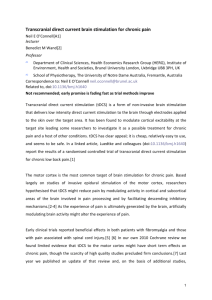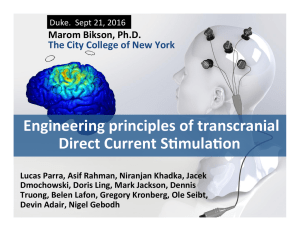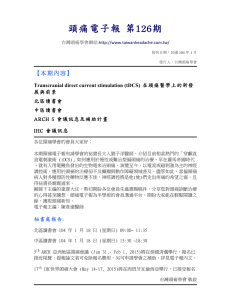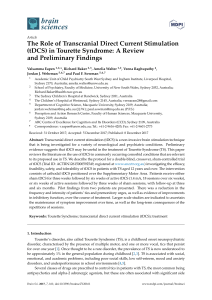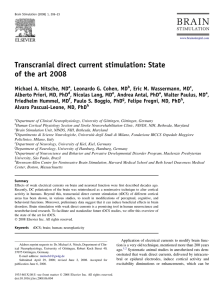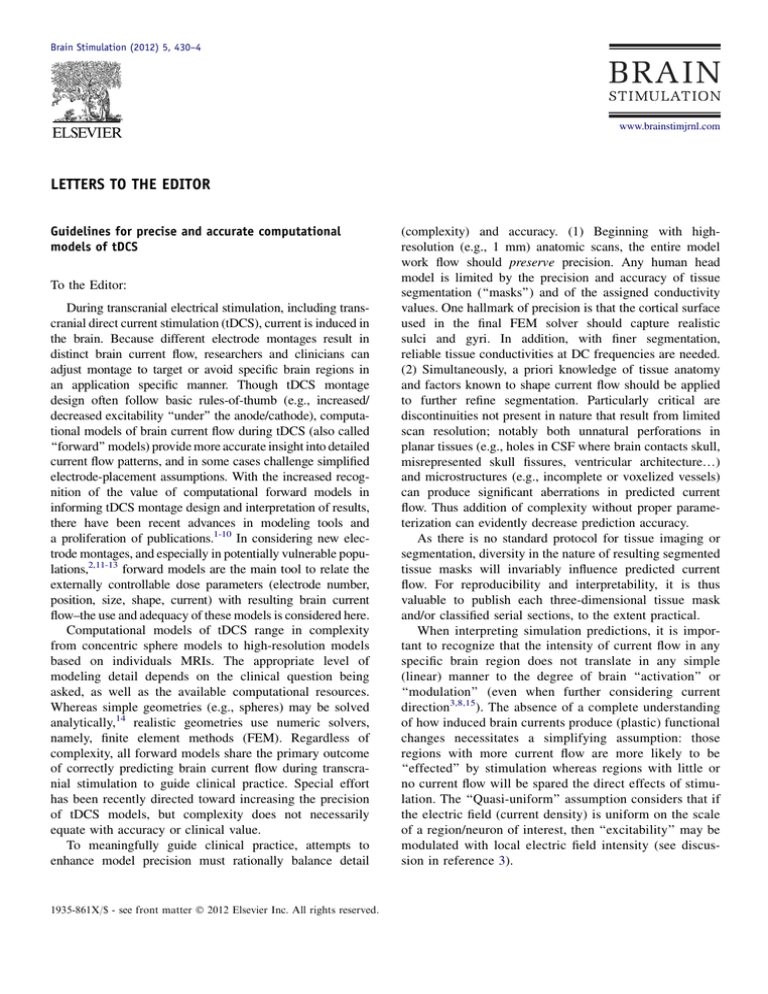
Brain Stimulation (2012) 5, 430–4
www.brainstimjrnl.com
LETTERS TO THE EDITOR
Guidelines for precise and accurate computational
models of tDCS
To the Editor:
During transcranial electrical stimulation, including transcranial direct current stimulation (tDCS), current is induced in
the brain. Because different electrode montages result in
distinct brain current flow, researchers and clinicians can
adjust montage to target or avoid specific brain regions in
an application specific manner. Though tDCS montage
design often follow basic rules-of-thumb (e.g., increased/
decreased excitability ‘‘under’’ the anode/cathode), computational models of brain current flow during tDCS (also called
‘‘forward’’ models) provide more accurate insight into detailed
current flow patterns, and in some cases challenge simplified
electrode-placement assumptions. With the increased recognition of the value of computational forward models in
informing tDCS montage design and interpretation of results,
there have been recent advances in modeling tools and
a proliferation of publications.1-10 In considering new electrode montages, and especially in potentially vulnerable populations,2,11-13 forward models are the main tool to relate the
externally controllable dose parameters (electrode number,
position, size, shape, current) with resulting brain current
flow–the use and adequacy of these models is considered here.
Computational models of tDCS range in complexity
from concentric sphere models to high-resolution models
based on individuals MRIs. The appropriate level of
modeling detail depends on the clinical question being
asked, as well as the available computational resources.
Whereas simple geometries (e.g., spheres) may be solved
analytically,14 realistic geometries use numeric solvers,
namely, finite element methods (FEM). Regardless of
complexity, all forward models share the primary outcome
of correctly predicting brain current flow during transcranial stimulation to guide clinical practice. Special effort
has been recently directed toward increasing the precision
of tDCS models, but complexity does not necessarily
equate with accuracy or clinical value.
To meaningfully guide clinical practice, attempts to
enhance model precision must rationally balance detail
1935-861X/$ - see front matter Ó 2012 Elsevier Inc. All rights reserved.
(complexity) and accuracy. (1) Beginning with highresolution (e.g., 1 mm) anatomic scans, the entire model
work flow should preserve precision. Any human head
model is limited by the precision and accuracy of tissue
segmentation (‘‘masks’’) and of the assigned conductivity
values. One hallmark of precision is that the cortical surface
used in the final FEM solver should capture realistic
sulci and gyri. In addition, with finer segmentation,
reliable tissue conductivities at DC frequencies are needed.
(2) Simultaneously, a priori knowledge of tissue anatomy
and factors known to shape current flow should be applied
to further refine segmentation. Particularly critical are
discontinuities not present in nature that result from limited
scan resolution; notably both unnatural perforations in
planar tissues (e.g., holes in CSF where brain contacts skull,
misrepresented skull fissures, ventricular architecture.)
and microstructures (e.g., incomplete or voxelized vessels)
can produce significant aberrations in predicted current
flow. Thus addition of complexity without proper parameterization can evidently decrease prediction accuracy.
As there is no standard protocol for tissue imaging or
segmentation, diversity in the nature of resulting segmented
tissue masks will invariably influence predicted current
flow. For reproducibility and interpretability, it is thus
valuable to publish each three-dimensional tissue mask
and/or classified serial sections, to the extent practical.
When interpreting simulation predictions, it is important to recognize that the intensity of current flow in any
specific brain region does not translate in any simple
(linear) manner to the degree of brain ‘‘activation’’ or
‘‘modulation’’ (even when further considering current
direction3,8,15). The absence of a complete understanding
of how induced brain currents produce (plastic) functional
changes necessitates a simplifying assumption: those
regions with more current flow are more likely to be
‘‘effected’’ by stimulation whereas regions with little or
no current flow will be spared the direct effects of stimulation. The ‘‘Quasi-uniform’’ assumption considers that if
the electric field (current density) is uniform on the scale
of a region/neuron of interest, then ‘‘excitability’’ may be
modulated with local electric field intensity (see discussion in reference 3).
Letters to the editor
There is a dearth of experimental data validating direct
model predictions of induced brain current flow14 or relating
these predictions to experimental/clinical outcomes.12,13,16
And there has been no comprehensive effort to differentiate
the impact on modeling techniques in regard to their clinical
use. Moreover, most modeling studies are published as
‘‘case’’ reports with single head analysis10,15,17 and thus
have limited consideration of variance across individualsd
even as increasingly precise patient-specific models12,13
illustrate the impact of idiosyncratic anatomic differences.
Modeling results can be presented phenomenologically,
with current flow maps used by clinicians as a ‘‘look-up
table’’ predicting activated and spared regions (given the
caveats outlined above). But the applied value of a model
follows specific predictions explaining existing data (in
ways not obvious) and/or suggesting experimentally testable outcomes (notably when unexpected). In either case
explicating hypotheses, including specifying to which
populations they apply and underlying assumptions,
provides practical insight into clinical decisions.
The increased exploration of tDCS to treat diverse
neuropsychiatric diseases and the desire to rationally
optimize tDCS dose requires an understanding of which
brain regions are targeted. Even working within existing
unknown tDCS mechanisms, forward models thus serve as
a key framework in developing electrical stimulation
strategies and elucidating study outcomes–and indeed may
thus provide a substrate for explaining the mechanisms.
Marom Bikson, PhD
Department of Biomedical Engineering
The City College of the City University of New York
New York, NY
Abhishek Datta, PhD
Laboratory of Neuromodulation
Spaulding Rehabilitation Hospital
Harvard Medical School, Boston, MA
E-mail address: abhishek.datta@gmail.com
doi:10.1016/j.brs.2011.06.001
References
1. Miranda PC, Lomarev M, Hallett M. Modeling the current distribution
during transcranial direct current stimulation. Clin Neurophysiol 2006;
117:1623-1629.
2. Wagner T, Fregni F, Fecteau S, Grodzinsky A, Zahn M,
Pascual-Leone A. Transcranial direct current stimulation:a computerbased human model study. Neuroimage 2007;35:1113-1124.
3. Datta A, Elwassif M, Battaglia F, Bikson M. Transcranial current stimulation focality using disc and ring electrode configurations:FEM
analysis. J Neural Eng 2008;5:163-174.
4. Oostendorp TF, Hengeveld YA, Wolters CH, Stinstra J, van Elswijk G,
Stegeman DF. Modeling transcranial DC stimulation. Conf Proc IEEE
Eng Med Biol Soc 2008;2008:4226-4229.
5. Datta A, Bansal V, Diaz J, Patel J, Reato D, Bikson M. Gyri-precise
head model of transcranial direct current stimulation: improved spatial
431
6.
7.
8.
9.
10.
11.
12.
13.
14.
15.
16.
17.
focality using a ring electrode versus conventional rectangular pad.
Brain Stimulation 2009;2:201-207.
Suh HS, Kim SH, Lee WH, Kim TS. Realistic simulation of transcranial direct current stimulation via 3-D high resolution finite element
analysis: effect of tissue anisotropy. Conf Proc IEEE Eng Med Biol
Soc 2009;2009:638-641.
Sadleir RJ, Vannorsdall TD, Schretlen DJ, Gordon B. Transcranial
direct current stimulation (tDCS) in a realistic head model. Neuroimage 2010;51:1310-1318.
Salvador R, Mekonnen A, Ruffini G, Miranda PC. Modeling the electric field induced in a high resolution head model during transcranial
current stimulation. Conf Proc IEEE Eng Med Biol Soc 2010;2010:
2073-2076.
Parazzini M, Fiocchi S, Rossi E, Paglialonga A, Ravazzani P. Transcranial direct current stimulation: estimation of the electric field and
of the current density in an anatomical head model. IEEE Trans
Biomed Eng 2011;58:1773-1780.
Mendonca ME, Santana MB, Baptista AF, et al. Transcranial DC stimulation in fibromyalgia: optimized cortical target supported by
high-resolution computational models. J Pain 2011;12:610-617.
Datta A, Bikson M, Fregni F. Transcranial direct current stimulation in
patients with skull defects and skull plates: high-resolution computational FEM study of factors altering cortical current flow. Neuroimage
2010;52:1268-1278.
Halko MA, Datta A, Plow EB, Scaturro J, Bikson M, Merabet LB.
Neuroplastic changes following rehabilitative training correlate with
regional electric field induced with tDCS. Neuroimage 2011;57:
885-891.
Datta A, Baker JM, Bikson M, Fridriksson J. Individualized model
predicts brain current flow during transcranial direct-current stimulation
treatment in responsive stroke patient. Brain Stimul 2011. In Press.
Rush S, Driscoll DA. Current distribution in the brain from surface
electrodes. Anesth Analg 1968;47:717-723.
Turkeltaub PE, Benson J, Hamilton RH, Datta A, Bikson M,
Coslett HB. Left lateralizing transcranial direct current stimulation
improves reading efficiency. Brain Stimul 2011. In Press.
Keeser D, Padberg F, Reisinger E, et al. Prefrontal direct current stimulation modulates resting EEG and event-related potentials in healthy
subjects: a standardized low resolution tomography (sLORETA) study.
Neuroimage 2011;55:644-657.
Bikson M, Datta A, Rahman A, Scaturro J. Electrode montages
for tDCS and weak transcranial electrical stimulation: role of
‘‘return’’ electrode’s position and size. Clin Neurophysiol 2010;121:
1976-1978.
Efficacy and safety of bifocal tDCS as an
interventional treatment for refractory schizophrenia
To the Editor:
Despite advances in pharmacotherapy, some disabling
symptoms remain refractory in 30% of patients with
schizophrenia such as auditory hallucinations (AH) and
negative symptoms. In this context, peripheral neurostimulation techniques have been proposed to curtail these
symptoms by modulating the abnormal cortical activity
reported in neuroimaging studies.1 Thus: (1) ‘‘activating’’
high-frequency repetitive transcranial magnetic stimulation
(rTMS) to the left dorsolateral prefrontal cortex (l-DLPFC)
This study was supported by two grants: the first from Region Rh^one
Alpes, France (BIR MIRA2008; Cluster 11 - HVN) and the second from
Le Vinatier Hospital (CSR 2007).





